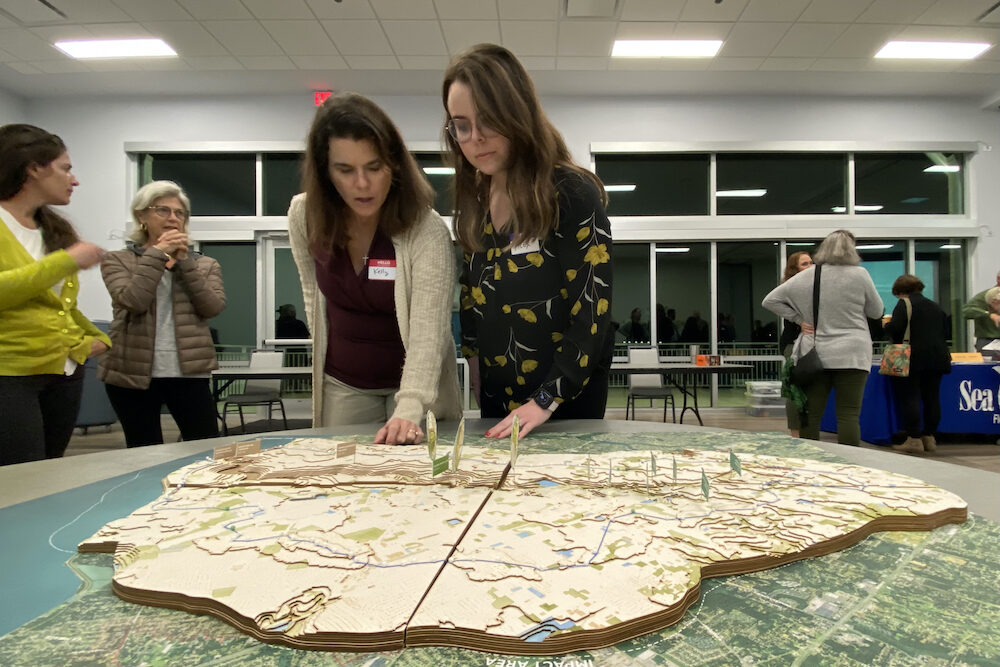by Jeremy Morrison
Years in the making, the Carpenter Creek and Bayou Texar Watershed Management Plan is almost finished.
“A lot of time and energy have gone into this,” said Pensacola Mayor Grover Robinson.
Meant to serve as a blueprint for restoration of the Carpenter Creek and Bayou Texar watershed going forward, a draft version of the management plan was presented Nov. 15 at the Bayview Community Center. The plan — an Escambia County-led, RESTORE-funded effort — is expected to be finalized within a month.
“We’re not slowing down, this isn’t going to sit on the shelf,” Escambia County Commissioner Robert Bender told a packed house in attendance for the unveiling of the draft version.
The genesis of this watershed management plan flows back to 2016, when Robinson, then an Escambia County commissioner, suggested such an effort seek RESTORE funding, a source of restoration funding established several years earlier and stemming from environmental penalties associated with the 2010 Deepwater Horizon oil spill.
Work on the Carpenters Creek and Bayou Texar Watershed Management Plan began in earnest with a workshop in late 2019. Since then, county and city officials, along with a collective of community partners and private consultants, have studied watershed conditions, gathered community and stakeholder input and identified a host of potential projects that could help to improve conditions within the watershed, such as erosion and sedimentation issues.
After earlier presenting a collection of 15 restoration projects, a trio of so-called catalytic projects — considered high-priority according to community input — have been identified. It is these three projects — beginning at an erosion-sensitive site near Davis Highway — that will be focused on first, once funding has been secured.
The management plan’s top-priority project spans the run of Carpenters Creek from the overpass at Davis Highway, around the bend to Airport Boulevard. It’s a run of about 1,440-feet, and one that the watershed management plan team has termed “a critically urgent segment of proposed restoration that will improve water quality further downstream.”
In addition to addressing bank erosion issues in this area, the proposed management plan project also includes a multi-modal trail running from Davis to Airport, as well as a nature trail that incorporates an existing stormwater pond and also a potential kayak launch on the creek itself which would serve to connect this stretch of the creek to the Bayou Texar blueway.
The second catalytic project identified in the watershed plan recognizes the historic and cultural significance of ‘Jennie’s Swimming Hole,’ located in a section of Carpenters Creek near the AMC movie theater off Bayou Boulevard. This area — so-named for Jennie Hudgins, a matriarch of Pensacola’s Black community and co-founder of the New Hope Missionary Baptist Church — is considered culturally and historically significant for the area’s African-American community.
In addition to the environmental restoration of Jennie’s Swimming Hole, this project calls for general creek restoration in the area and the creation of a multi-modal trail featuring a 45,000 square-foot lawn, picnic area and art walk.
Finally, the watershed plan identifies a catalytic project area in the section of Carpenters Creek near 9th Avenue. This project features creek restoration, and also the creation of trails designed to link up routes heading into various areas of towns, such as toward downtown Pensacola.
While the watershed management plan team has selected these catalytic projects through the public input process, funding must still be secured before proceeding. Matt Posner, director of the Pensacola Bay Estuary Program, said that he expects about $2.2 million in RESTORE funding to be soon confirmed, which the estuary program applied for to cover the design and permitting work required for Carpenter Creek restoration efforts from I-110 to 12th Avenue, an area which encompasses all three catalytic projects in the watershed.
“So, the three catalytic projects,” Posner clarified, “were essentially packaged together for funding for design.”
A final decision from the Florida Department of Environmental Protection regarding this chunk of RESTORE funding is expected by the middle of December. If the funding is approved, these catalytic projects would still require further funds to push them through to the development phase.
Funding aside, the work will take a while once these watershed projects commence. Combined, the watershed plan lays out more than a decade worth of restoration work.
“This has been a problem decades in the making, so it takes some time to cure that,” noted John Kiefer, a biophysical engineer and technical advisor on the management plan team.
Kiefer also said that because this work — with the three catalytic projects and any other projects listed in the overall management plan — will be carried out over such a span of time, conditions in the watershed, such as sediment loads and erosion risks, will need to be closely observed and factored into a sort of living plan.
“Because it’s spread out over some years, things can change,” Kiefer said.
While this new Carpenters Creek and Bayou Texar management plan prioritizes the three catalytic projects, efforts are also being made on other restoration projects geared toward improving conditions within the watershed.
Escambia County is currently working on designing a stormwater pond near the Olive Road headwaters site of Carpenters Creek. The project would be beneficial overall for water quality downstream and a funding decision from the FDEP’s Resilient Florida Program is expected early next year.
Also, another project focused on adding additional stormwater outfalls, or filtering systems, to sites emptying into Bayou Texar is also awaiting a funding decision, with the city having applied for some of those FPL 3b RESTORE funds. This project also would improve water quality within the watershed.
